Affiliate disclosure: This post may contain affiliate links. Please see our Privacy Policy.
Dock seeds are readily available in the wild, and they can be ground into a wild foraged flour with minimal preparation.
While some of the foraged “flour” you can make seems a bit of a stretch, yellow dock is actually a distant relative of buckwheat. The seeds have a similar taste, can be toasted and ground into a wild foraged gluten-free flour.
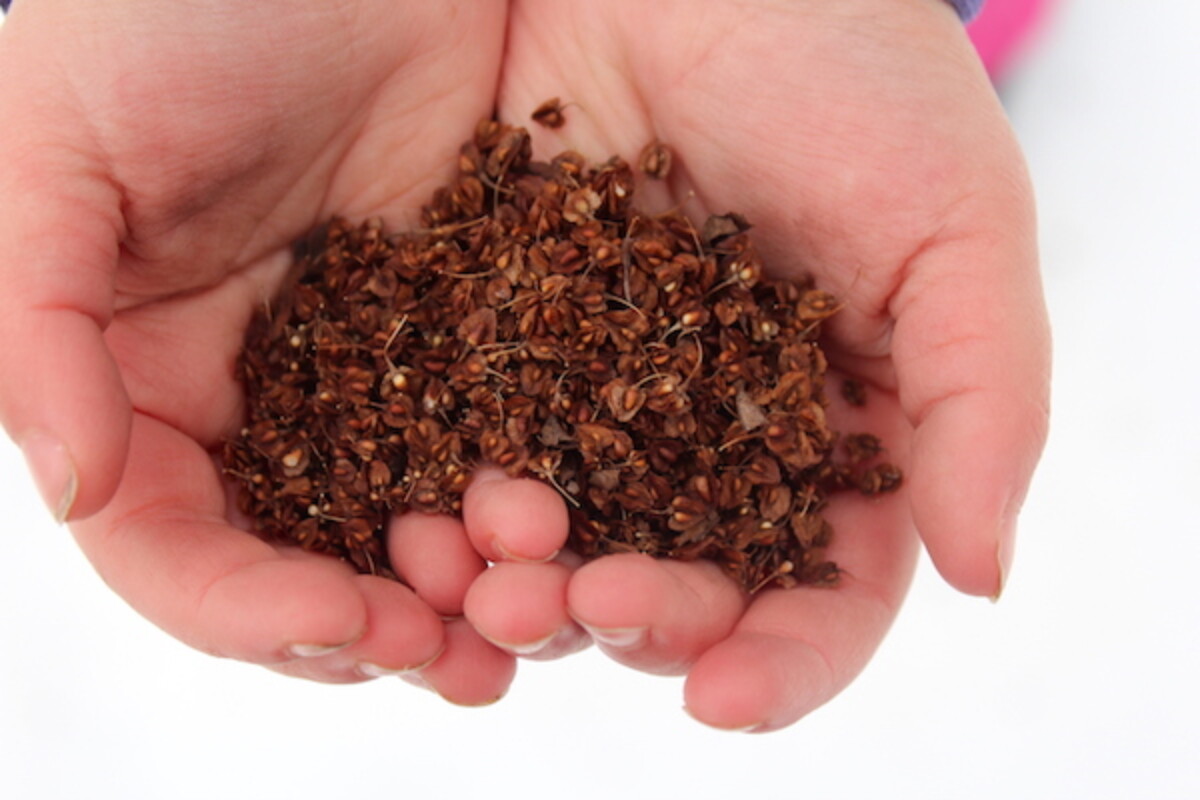
With two toddlers in the house, this year’s foraging often meant crafting wild foraged treats to peak a little one’s excitement. Foraging with kids can be a challenge, but there’s nothing like bringing back a haul and then spending a bit of quality time in the kitchen making wild foraged cookies as a family.
Often the “flour” you can harvest in the wild isn’t exactly what we’d call flour in the grocery store. Red clover flour, for example, is made from a blossom rather than a grain, so it’ll cook very differently. Similarly, pine bark flour or birch bark flour are made from tree bark, not grain.
If you want real “flour” you need to harvest seed and dock seeds fit the bill nicely.

The plants themselves are cosmopolitan, growing just about everywhere in the world. They’re considered a noxious invasive in many places, and for good reason.
Once dock plants get established they really take over. Prolific seed production, combined with a weedy persistence that just needs the smallest crack to thrive.
Add in a perennial growth habit, and you’ve got a recipe for a persistent weed…that just happens to be a good wild food source in both the country and city.
Dock seeds are abundant much of the year, which is especially convenient when you’re foraging in the winter or late fall when other foods are scarce. The seed stalks persist through the winter months, and since they’re quite tall they’ll remain available above the snow.
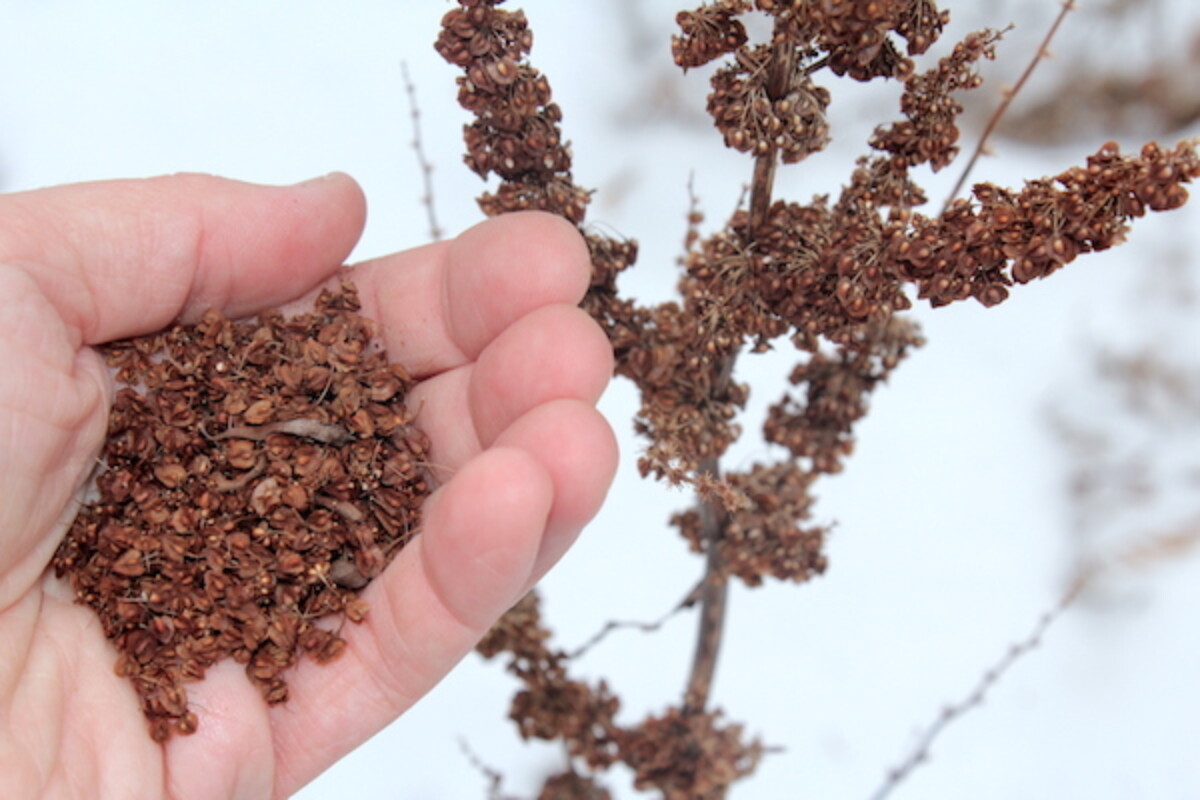
Dock plants are perennials, which means they re-sprout from the same spot year after year. In the very late winter and early spring, the new dock plants will sprout and begin to form leaves right under last year’s seed stalks. As that new green growth begins, last year’s seeds are often still clinging to the stalk.
Since dock seeds persist all the way until spring greens sprout, their form allows you to keep foraging during an otherwise bleak early spring mud season. They’ll bring a smile to my face in the spring landscape, long before the first dandelion blossoms.
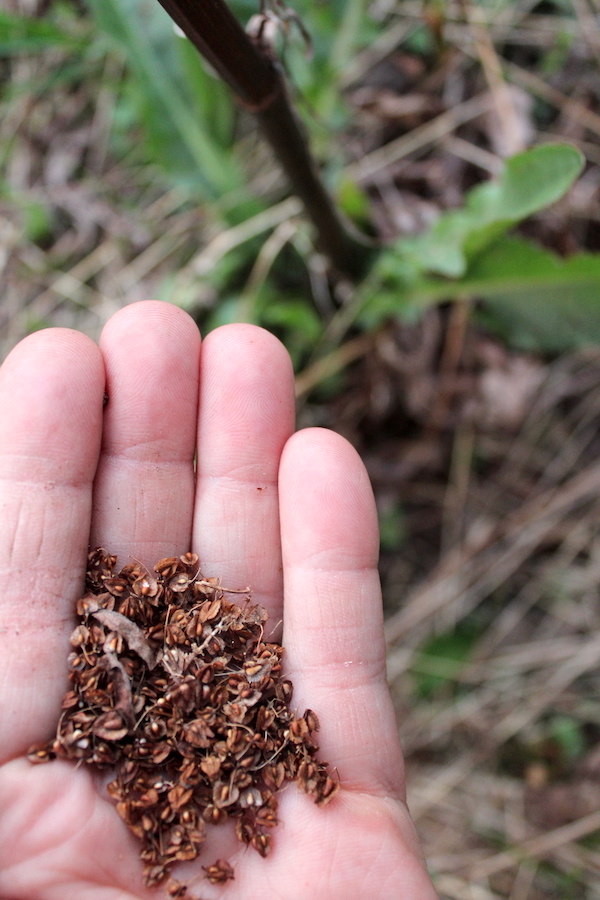
The individual seeds are inside of a papery husk, and it can be difficult to winnow the seeds from the chaff. I’ve read about multiple methods, none of which seem to be very effective.
The general conclusion seems to be…skip it. Grind the whole seed and chaff into flour, and get a bit of extra fiber in your diet.
The chaff of dock seed doesn’t have much in the way of nutrition, but it won’t hurt you and it’ll help add bulk to your diet. Dock seeds can be used whole to make dock seed crackers, but for most purposes, it’s better to grind it into flour.
To make dock seed flour, start by collecting as much dock seed as you can. The seeds come off the stalk easily once they’re dried, and in an area full of dock seed you should be able to collect several cups in just a few minutes.
Attempting to grind the raw seeds is difficult since while they seem dry in hand, the husks are still quite supple. To really grind easily, the seeds need to be very dry. I’ve found the best method is to toast them on a tray in the oven for about 8-10 minutes.
Be careful to just toast them, not allowing them to burn. Let the dock seeds cool completely before grinding them in a food processor. (or mortar and pestle if you prefer)
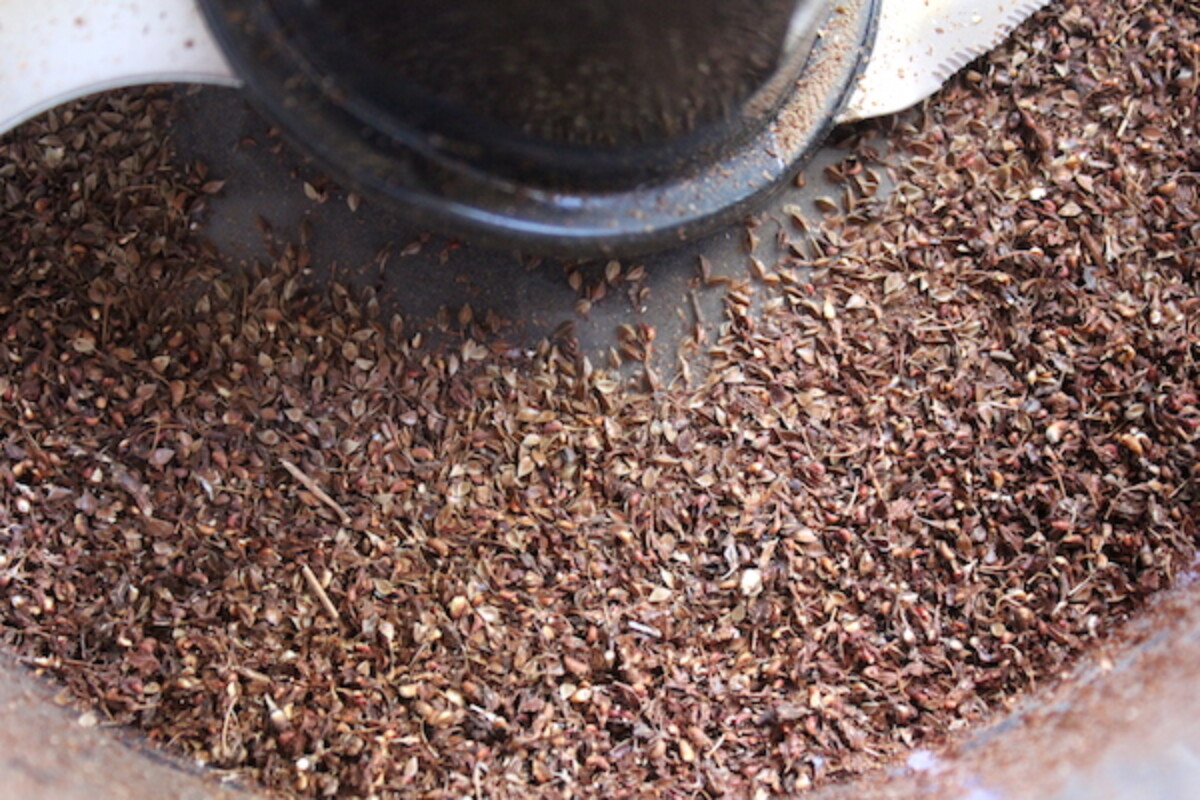
The flour can be substituted into your recipes for about up to 1/4 of the flour in the recipe. Keep in mind that it doesn’t have gluten, so the bread won’t rise as high and the texture will be heavier. It’s best to use it in things like crackers or brownies where a heavy texture works well.
How Does Dock Seed Flour Taste?
For an all wild foraged cookie, we mixed dock seed flour with a bit of pine bark flour to make these bark cookies. The kids really enjoyed them, but to me, they mostly tasted like what they were…bark. The flavor of these had more to do with the bark than the dock seeds, and in general, the seeds of yellow dock taste good, a bit like buckwheat.
The main difference? Dock seeds have quite a bit of bitterness that you don’t generally find in supermarket flours.
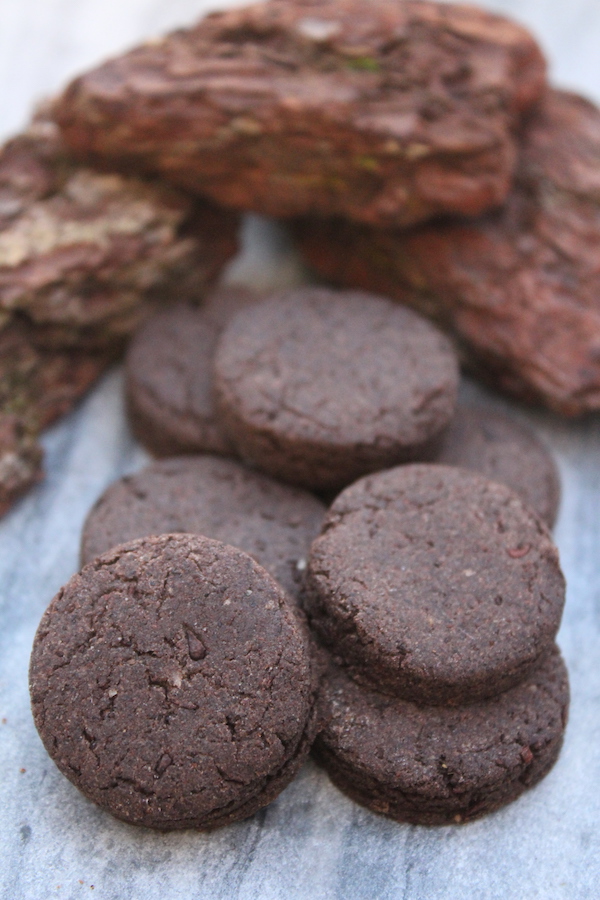
Samuel Thayer describes many different preparations for dock in his book Nature’s Garden. After going through different ways to cook dock shoots, greens, and roots, he moves on to the seeds noting that “This is the last and perhaps least edible part of this incredibly versatile food plant.
Dock is in the same family as buckwheat, and its seed resembles those of buckwheat in miniature…The seeds themselves are unpleasantly bitter.”
I’ll grant they are bitter, but to my palate, they’re actually the most edible part of the plant. The roots of yellow dock, which many people describe eating, caused me to spend 10 minutes trying to scrub the taste off my tongue.
The leaves are only slightly better. The seeds though aren’t half bad in my book, and they’re readily available. To each his own I guess?
Dock Seed Flour Recipes
While you can try substituting dock seed flour into your own recipes, here are a few ideas to try with your wild foraged grain:
- Dock Seed Brownies – Learning and Yearning
- Double Chocolate Curly Dock Seed Cake – Gather Victoria
- Dock Seed Berry Cake – North West Forager
- Dock Seed Crackers – Homegrown and Hand Gathered
- 100% Dock Seed Bread – Sparrow Chef
- Dock and Lambs Quarter Crackers – Edible Wild Food (These also require foraging lambs quarter seed, also known as wild quinoa, which is just as common as the wild dock.
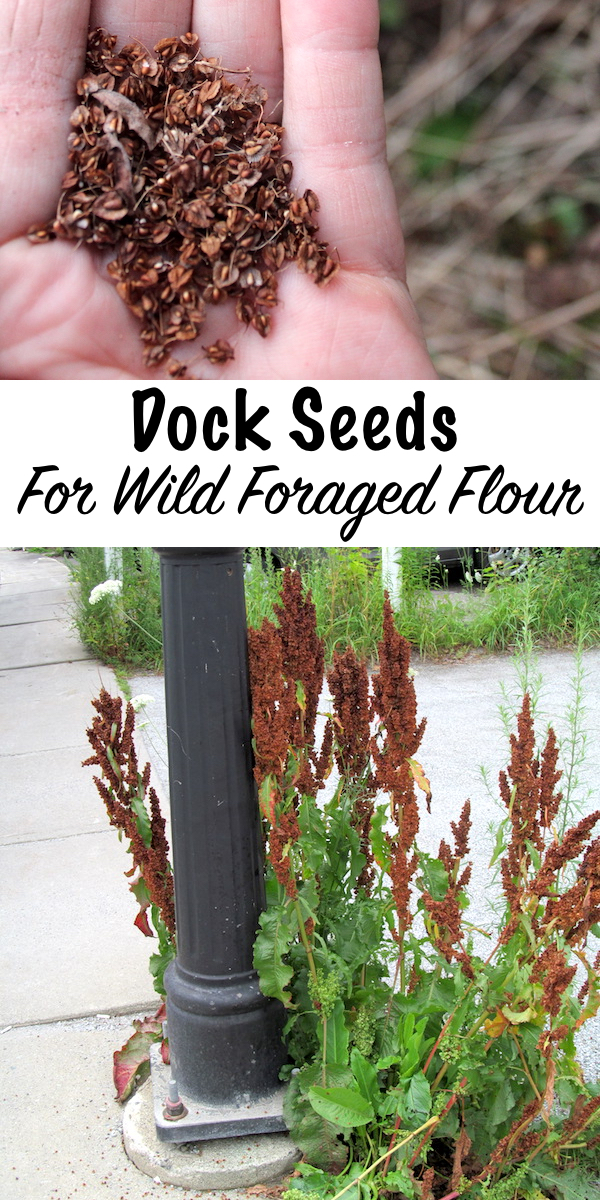
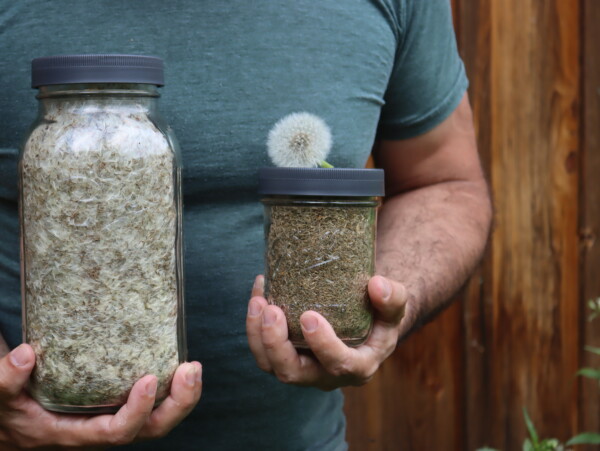
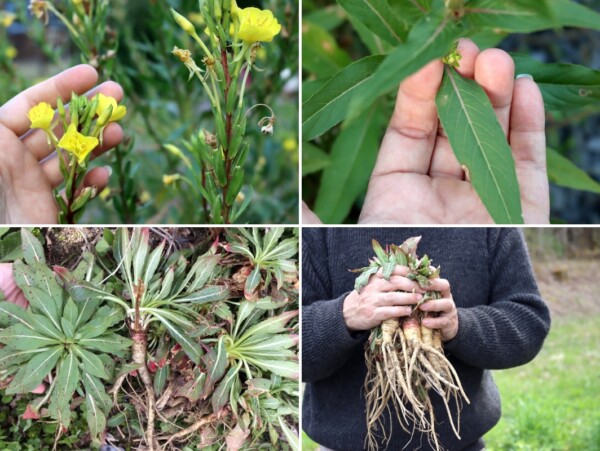
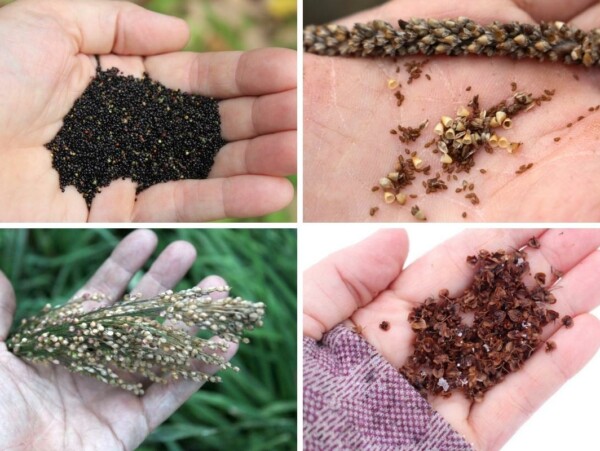
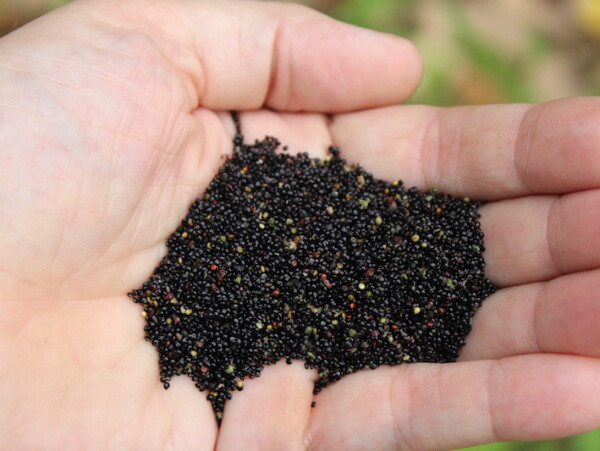










How about sprouting the seeds? 🙂
I haven’t personally tried the sprouted seeds from dock. I do know that most people say that the taste is much better after the seeds have turned brown.
I am trying to find whether or not dock seeds can be harvested while they are still green? I see by a previous answer that the dock seeds can be harvested any time of the year. To the reader, one might assume they can still be harvested no matter how long they have been dried on the stalk. Are there any disadvantages in harvesting seeds while they are still green? And are there any medicinal benefits to using dock seeds? Thanks!
You can harvest them when they are green but it is my understanding that the flavor is much better once they have dried on the stalk.
Hello! I have come across your blog several times lately and have so far always enjoyed reading your articles and seeing your photos. We seem to have a lot of common interests in perennials and wild foods 🙂
After reading this post I wanted to mention that I discovered a method of cleaning dock seeds a few years ago by trial and error using water. I also use the same method to clean sorrel and orach seeds which have similar paper husks/bracts as well.
Its actually very easy to do! I outlined the method on our website article titled Cleaning Wet Seeds at the bottom in the section titled “De-Husking Seeds in Water”: https://homesteadculture.com/cleaning-wet-seeds-wet-processing-seeds/
I describe the process in detail. A bit later this season I plant to document with photos and/or video as well. But the gist of it is you put the seeds in a bucket, add small amount of water to cover, rub thoroughly with your hands until the paper sheaths release the seeds. Then fill the bucket with water and decant the husks from the seed, repeat until the husks are all poured off and the water is clear. Be sure to dry the seeds right away unless you want them to sprout 😛
Anyway I though you might appreciate that bit about cleaning dock seeds!
Noel
Thanks for sharing.
You are very welcome!
I’ve just ground my first batch and will use some in my sourdough loaf. Do you have any information on the nutritional profile of the seeds? Thank you!
I’m sorry I don’t have that information but if you find out let us know.
Must we wait for fall and winter to harvest? Here in Pennsylvania in mid-June our curly dock plants are loaded with green seeds. Can I dry, roast then grind these green seeds?
You can forage dock seeds any time of the year.
Thanks so much for your knowledge! Igot some drying in the oven right now : )
You’re very welcome.
Haha, we seem to fall on opposite sides of the dock spectrum! I feast on the leaves all spring, but I just…can’t…stand the seeds, no matter how hard I’ve tried. Perhaps the bitterness just hits me in a different way? Or, I wonder if it’s my particular strain of local curly dock that makes it taste so unpleasant, or if some of us are genetically disposed to taste different flavors differently? No one will research it, of course, but it’s a curious thing to ponder. Thanks for your write up–I enjoy comparing foraging notes with you.
You’re welcome. So glad you enjoyed the post.
I wonder if the bitterness could be removed by boiling/rinsing, the way folks do with bitter acorns to leach out tannins. Burdock does contain tannins. Then dry the seed and process into flour.
Burdock (Arctium) and dock (Rumex) aren’t the same plant, but they both contain tannins.
I looked at these recipes and some specify yellow dock and others curly dock. Does it matter which dock is used? If so, what is the difference in the taste? Thanks!
Yellow dock and curly dock are both common names for the same rumex species, Rumex crispus.
Thanks for this! I was just wondering how long I should expect the flour to last? I am assuming that the freezer in a tightly sealed container is my best bet (I do this with my flour too)…
The greens are amazing and my favorite salad ingredient. (If they are harvested from plants that grow away from traffic and, most importantly, in a shady area.)
Before I attempt to grind the seeds in my flour mill, I’m going to ask if anyone else has tried this and if their mill survived?
Ha…I haven’t tried it, but I wish you luck. Let me know how it goes!
my dock seeds ground up nicely in my blender
what is the seeds nutritional and medicinal value? constituents? do you know?
A good question, but I don’t have the answer. I did a bit of research but didn’t come up with anything.
Very interesting. Thanks for sharing. I would love to see what the flour looks like after it’s ground.
What does the plant look like?
Good question. I need to add some summer plant pictures, all those seed stalk pictures were taken in late March, after the stalks had overwintered. I’ll add in some plant photos when they pop up in the summer. Here’s some pictures (and a way to eat the leaves) in the meantime: https://honest-food.net/curly-dock-edible/